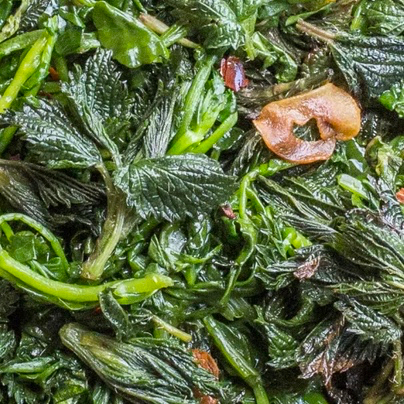THE HOME - COOKING GREENS FOR MORE VITAMINS
Most tougher wild greens (like dock, dandelion, creasies, nettles, and such) are cooked down (boiled) and then fried in bacon grease or with salt pork or fat back and then served with salt and pepper and a splash of vinegar.
Traditional recipes call for this because for optimum nutrition, impenetrable and indigestible
plant cell walls break down more easily when combined with fats and acids. Raw vegetables are not actually digested well by the human gut. Plant cell walls are like little maximum security prisons. These cell
walls need to be "cooked" to be broken open.
"Cooked" simply means whatever makes the cell walls open up. This includes:
- heating (steaming, boiling, roasting, frying)
- drying
- freezing
- fermenting
- soaking in oil and marinating for a few minutes (such as with salad greens) or storing in oils
Most people think cooking raw produce causes them to lose nutrients. This is both true and false. While it's true that Vitamin C is destroyed in cooking, Vitamin A, among other nutrients, actually increases. This is especially true with greens and the Vitamin A in wild greens far exceeds the amount in cultivated greens.
A notable exception of this rule applies to potatoes. Though not a green, their Vitamin C, if cooked in the jacket, does not get destroyed in cooking. The issue isn't as much the heating as the oxidizing. Once Vitamin C is exposed, it oxidizes and dissipates. This is why packaged orange juice, for example, actually has no Vitamin C at all. (USDA nutrition labels are based on the raw ingredients.)
The easiest method to cook wild greens is also the simplest method for cooking any cultivated ones. The only difference is in the blanching time. Cultivated greens may take only seconds while wild greens may take 5-15 minutes to cook to the consistency and flavor you want.
Some leaves are very tender and only need to be steamed. Young nettles, cresses, lamb's quarters, and violet leaves may only need to be steamed for 1 minute. Older or tougher greens, like dandelion, dock, Turkish rocket, and garlic mustard, should be blanched until they are tender.
RECIPE: EASY COOKED WILD GREENS
Ingredients:
- 2 cups cooked greens (4 cups raw - about 8 oz.)
- salt to taste
- olive oil for cooking and dressing
- 1 clove garlic, minced
- lemon wedges for dressing
- crushed red pepper flakes
- Chop long pieces of greens coarsely. Leave small pieces as they are.
- Blanch the greens in boiling, salted water 10-15 minutes until they taste good to you. OR steam more tender leaves.
- Saute the minced garlic in oil about 4 minutes on medium heat or until browning.
- Add a pinch of red pepper flakes, stir and then add the greens and stir until they are coated well with garlic and oil.
- Heat them thoroughly adding salt and any other herbs or spices you would like.
- Serve hot with lemon slices for dressing and extra oil if desired.
RECIPE: TRADITIONAL - A MESS OF GREENS
Ingredients:
- greens of your choice - wild or cultivated (chard, turnip, beet, mustard) about 8 oz or 4 cups raw
- bacon or bacon grease, fat back, or salt pork
- pepper
- onion, chopped
- vinegar
- Blanch/boil greens until they are tender - 3 to 20 minutes depending on the greens.
- While the greens are cooking, lay some bacon, fat back, or salt pork in a fry pan and fry it up. Or just heat up bacon grease so the pan is well greased.
- Add chopped onion and saute until tender and cooked through.
- Drain and dry the greens somewhat so you don't get splattered with hot grease when added.
- Add the greens to the fry pan and mix well with the oil and onions. Add pepper. Saute about 1-3 minutes.
- Serve hot with a splash of vinegar.
Traditional plates of greens are usually served with cornbread and beans.
You can mix and match available greens. Use any herbs and spices you'd like to season your greens. You can add other foraged or garden foods, such as mushrooms or bell peppers, or garnish with peppery mustard flowers.
This is a great season for wild greens. They are still tender and their flower stalks have not grown yet - although unopened flower stalks can be cooked like broccoli raab (that recipe will be posted later in the season). In a world where rural people, pioneers, and colonists ate from their larder (pantry) over the winter, fresh wild greens were much appreciated and not wasted. Eating fresh greens revitalized them and made remaining bits of dried stores of food more palatable.
Remember to eat your greens! It's good mom advice, and right outside your door, there is a bounty to choose from right now.


Comments
Post a Comment